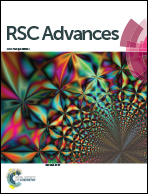Crystal structures, Hirshfeld surface analyses and thermal behavior of two new rare tetrahedral terminal zinc(ii) azide and thiocyanate Schiff base complexes†
Abstract
Two new rare terminal zinc(II) thiocyanate and azide Schiff base complexes of [ZnL(NCS)2] and [ZnL(N3)2] have been prepared by reaction between zinc thiocyanate and azide salts and a new bidentate Schiff base ligand entitled N,N′-bis((E)-3-(4-(dimethylamino)phenyl)allylidene)-2,2-dimethylpropane-1,3-diamine (L). The compounds were characterized by FT/IR, 1H NMR, 13C NMR, UV-visible spectroscopy and molar conductivity. The structures of the complexes were determined by single-crystal X-ray diffraction. The structural data showed that the Zn(II) ion in both complexes is in a distorted tetrahedral environment surrounded by two iminic nitrogen atoms of the Schiff base ligand and two isothiocyanate or azide anions. The crystal packing of the complexes shows intermolecular interactions including C–H⋯S, S⋯π and C–H⋯π interactions in the [ZnL(NCS)2] complex and C–H⋯N and C–H⋯π interactions in the [ZnL(N3)2] complex. The C–H⋯π interaction in these complexes is among the strongest reported interactions of this type. Hirshfeld surface analysis was employed to clarify the nature and extent of intermolecular interactions and showed the important role of C–H⋯π interaction in the structures of the two complexes. Moreover, the thermal behaviors of both compounds were investigated in the temperature range 25–800 °C, and the results showed that the ligand absolutely decomposes, but the zinc complexes leave metallic zinc as a final residue. Zinc complex nanostructures were also prepared via a sonochemical process and characterized by FT-IR spectroscopy, X-ray diffraction (XRD) and scanning electron microscopy (SEM).


 Please wait while we load your content...
Please wait while we load your content...